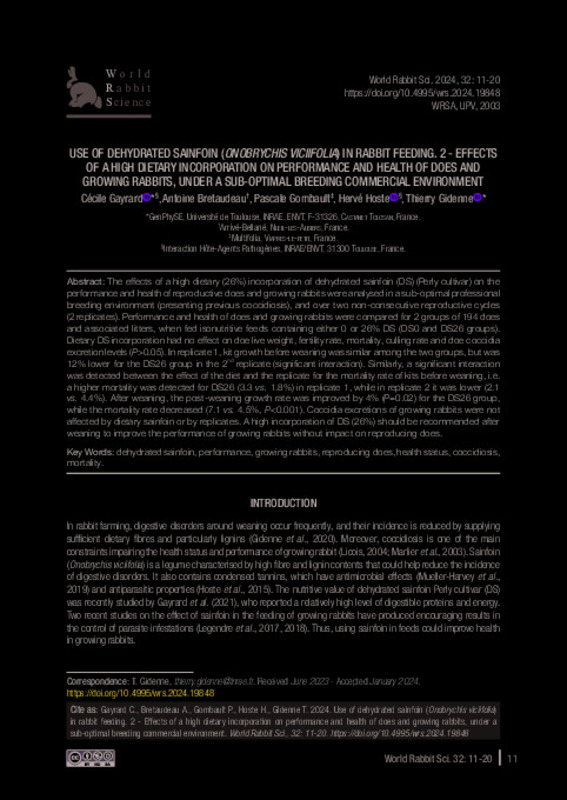JavaScript is disabled for your browser. Some features of this site may not work without it.
Buscar en RiuNet
Listar
Mi cuenta
Estadísticas
Ayuda RiuNet
Admin. UPV
Use of dehydrated sainfoin (Onobrychis viciifolia) in rabbit feeding. 2 - Effects of a high dietary incorporation on performance and health of does and growing rabbits, under a sub-optimal breeding commercial environment
Mostrar el registro sencillo del ítem
Ficheros en el ítem
| dc.contributor.author | Gayrard, Cécile
|
es_ES |
| dc.contributor.author | Bretaudeau, Antoine
|
es_ES |
| dc.contributor.author | Gombault, Pascale
|
es_ES |
| dc.contributor.author | Hoste, Hervé
|
es_ES |
| dc.contributor.author | Gidenne, Thierry Noël
|
es_ES |
| dc.date.accessioned | 2024-04-25T07:28:56Z | |
| dc.date.available | 2024-04-25T07:28:56Z | |
| dc.date.issued | 2024-03-28 | |
| dc.identifier.issn | 1257-5011 | |
| dc.identifier.uri | http://hdl.handle.net/10251/203730 | |
| dc.description.abstract | [EN] The effects of a high dietary (26%) incorporation of dehydrated sainfoin (DS) (Perly cultivar) on the performance and health of reproductive does and growing rabbits were analysed in a sub-optimal professional breeding environment (presenting previous coccidiosis), and over two non-consecutive reproductive cycles (2 replicates). Performance and health of does and growing rabbits were compared for 2 groups of 194 does and associated litters, when fed isonutritive feeds containing either 0 or 26% DS (DS0 and DS26 groups). Dietary DS incorporation had no effect on doe live weight, fertility rate, mortality, culling rate and doe coccidia excretion levels (P>0.05). In replicate 1, kit growth before weaning was similar among the two groups, but was 12% lower for the DS26 group in the 2nd replicate (significant interaction). Similarly, a significant interaction was detected between the effect of the diet and the replicate for the mortality rate of kits before weaning, i.e. a higher mortality was detected for DS26 (3.3 vs. 1.8%) in replicate 1, while in replicate 2 it was lower (2.1 vs. 4.4%). After weaning, the post-weaning growth rate was improved by 4% (P=0.02) for the DS26 group, while the mortality rate decreased (7.1 vs. 4.5%, P<0.001). Coccidia excretions of growing rabbits were not affected by dietary sainfoin or by replicates. A high incorporation of DS (26%) should be recommended after weaning to improve the performance of growing rabbits without impact on reproducing does. | es_ES |
| dc.description.sponsorship | Arrivé-Bellanné, Multifolia and ANRT funding this project and the doctoral programme (ANRT, CIFRE Programme) | es_ES |
| dc.language | Inglés | es_ES |
| dc.publisher | Universitat Politècnica de València | es_ES |
| dc.relation.ispartof | World Rabbit Science | es_ES |
| dc.rights | Reconocimiento - No comercial - Compartir igual (by-nc-sa) | es_ES |
| dc.subject | Dehydrated sainfoin | es_ES |
| dc.subject | Performance | es_ES |
| dc.subject | Growing rabbits | es_ES |
| dc.subject | Reproducing does | es_ES |
| dc.subject | Health status | es_ES |
| dc.subject | Coccidiosis | es_ES |
| dc.subject | Mortality | es_ES |
| dc.title | Use of dehydrated sainfoin (Onobrychis viciifolia) in rabbit feeding. 2 - Effects of a high dietary incorporation on performance and health of does and growing rabbits, under a sub-optimal breeding commercial environment | es_ES |
| dc.type | Artículo | es_ES |
| dc.identifier.doi | 10.4995/wrs.2024.19848 | |
| dc.rights.accessRights | Abierto | es_ES |
| dc.description.bibliographicCitation | Gayrard, C.; Bretaudeau, A.; Gombault, P.; Hoste, H.; Gidenne, TN. (2024). Use of dehydrated sainfoin (Onobrychis viciifolia) in rabbit feeding. 2 - Effects of a high dietary incorporation on performance and health of does and growing rabbits, under a sub-optimal breeding commercial environment. World Rabbit Science. 32(1):11-20. https://doi.org/10.4995/wrs.2024.19848 | es_ES |
| dc.description.accrualMethod | OJS | es_ES |
| dc.relation.publisherversion | https://doi.org/10.4995/wrs.2024.19848 | es_ES |
| dc.description.upvformatpinicio | 11 | es_ES |
| dc.description.upvformatpfin | 20 | es_ES |
| dc.type.version | info:eu-repo/semantics/publishedVersion | es_ES |
| dc.description.volume | 32 | es_ES |
| dc.description.issue | 1 | es_ES |
| dc.identifier.eissn | 1989-8886 | |
| dc.relation.pasarela | OJS\19848 | es_ES |








